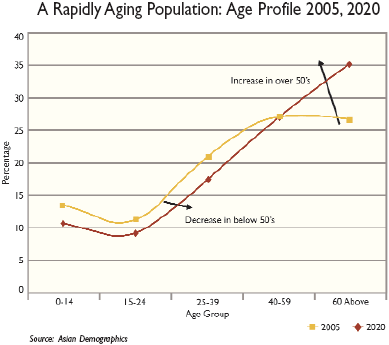Japan has the
world’s first “super-aging” society. Japan has a steadily declining
fertility rate, a shrinking population, and an aging population1.
Japan’s fertility rate2 declined to 1.29 children per
woman in 2003 which is far below replacement level. The following
chart shows Japan’s profile as a rapidly aging society.
Japan’s population is expected to shrink from the present 127 million
to about 100 million by 2050. This phenomenon of a shrinking population
with women outliving men is illustrated in the chart below.
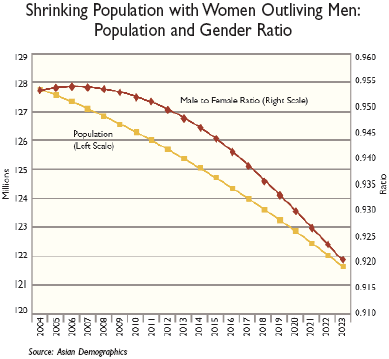
By 2025, over a quarter of Japan’s population will be over 65 years
old. Japan today has around 20,000 centenarians, a segment that
is growing fast, and most of them are women, as they generally outlive
men.
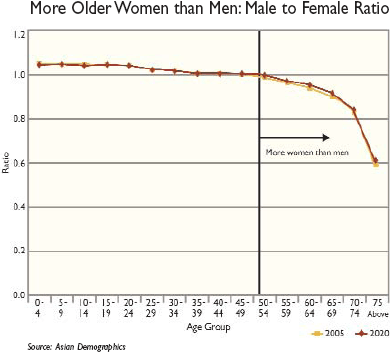
What makes Japan a “super-aging” society is that, while its demographic
trends have much in common with other developed countries in the
west, it is unique in its steadfast refusal to introduce a liberal
immigration policy to compensate for its shrinking and aging population.
In this regard, it is important to examine socio-economic consequences
such a “super-aging” society may entail. As will be seen below,
from the consumer market perspective, a salient feature of this
super-aging society is the emerging and increasingly important role
of Japan’s women consumers, especially the older women.
To
marry or not to marry?
One reason for
Japan’s declining fertility is that women are marrying late, or,
increasingly, not marrying at all. For example, the number of unmarried
Japanese women between the age of 30 and 34 almost doubled from
14% to 27% between 1990 and 2000. Similarly, the number of unmarried
women between the age of 35 and 39 increased from 8% to 14%. An
astonishing 54% of women in their 20s are single.
A popular term
has been coined by the best selling author Junko Sakai, makeimu
(loser dogs), to describe single career women in their 30s. This
is in contrast with kachiinu (winner dogs), who are married with
children3. “Loser dogs” bemoan the lack of suitable men.
They have cash to spare and they love to pamper themselves– visiting
beauty salons, health spas, and follow the latest fashion trends.
Time not spent raising children is devoted to their careers, and
to new hobbies, learning new languages and traditional Japanese
crafts. Savings are used to lavishly decorate their homes.
The phenomenon
of the “loser dogs” reflects an increasingly acute mismatch in Japanese
society between what men want and what women want. The weekly magazine
AERA conducted a survey that showed 80% of the men interviewed said
they would marry a woman who earned less than they did, while only
10% of the women interviewed said they would marry a man who earned
less than they did. About 60% of the men reported that they would
gladly become househusbands, while an equal percentage of women
said they would never want their spouses to be homemakers4.
As journalist
Philip Brazer observed, “…in marriage [Japanese] women have the
right not to have to make a living, while [Japanese] men have the
right not to do housework. But as earning a living has become more
difficult, housework has become easier. In the process, most men
have decided to give up their privileges, but most women haven’t.”5
There is therefore
an ongoing and lively debate on the desirability and socio-economic
consequences of “loser dogs” versus “winner dogs” in Japan. From
a demographic point of view, the consequences of the “loser dogs”
phenomenon is clear– several decades of low birth rates are flattening
the age-curve of first time mothers. Japanese women are having babies
both at a younger age (the “winner dogs”) and at a later age (the
“loser dogs” who finally find their men). This trend is illustrated
in the chart below.
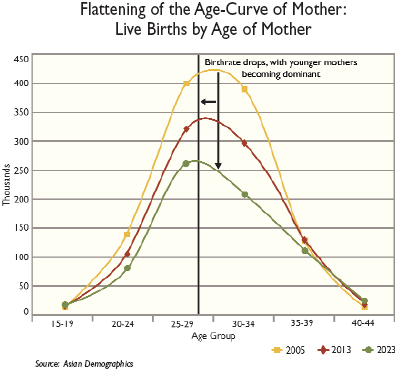
Rise
of the ‘empty nesters’
At the other
end of the spectrum from the unmarried younger women, the “loser
dogs,” are the empty nesters. These are households without any economically-dependent
children. Since women outlive men by a wide margin, many of the
empty nester households eventually turn into single-person households
that comprise of elderly women. In 2004, 34% of the elderly (65
and above) were living only with their spouses, and 14% of them
lived alone. In the coming decade, the latter percentage is set
to rise rapidly as more and more older single women will
be living on their own. This trend is reflected in a simultaneous
increase in the number of households and decrease in household size
as shown below.
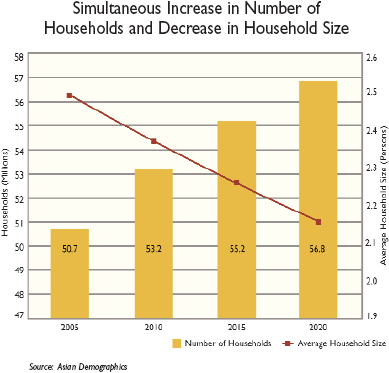
As detailed below, the emerging lifestyle and spending patterns
of these older single women will dominate the
shape and size of the women consumer market in Japan in the coming
years.
Women’s
role in the workforce
Twenty years
after the enactment of the Equal Employment Opportunity Law (enacted
in 1985), women’s role in the labor force remains marginal.
In 2003, only
3% of all company directors and 4.5% of managers were women in Japan’s
corporate sector.
Most women are employed in part-time work, defined as working less
than 34 hours a week. In 2004, there were over a million women part-time
workers in Japan, accounting for about 90% of the total.
Women’s marital
status is a key determinant to their employment and income status.
Typically, women leave the workforce after childbirth and return
to the workforce in their mid-40s when child-rearing duties are
reduced. This situation is reflected in the “M” curve pattern as
shown below.
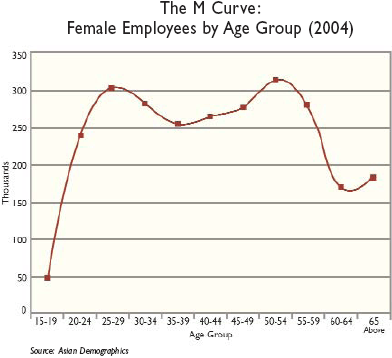
With the rise
of the “loser dogs” phenomenon, the middle part of the “M” curve
can be expected to flatten out in the coming decade, transforming
it into more like an inverted “U” curve with a wide flat top.
The prospects
of employment and income status improving for Japanese women, however,
are not encouraging. Japanese women are by and large very well educated.
But their education has yet to translate into better jobs and higher
incomes. A stagnating economy is one reason. The second reason is
that Japanese women tend to enroll in less rigorous, though expensive,
junior colleges that do not require the same tough entrance examinations
as in university admission. In 1996, for example, female students
accounted for only 22.9% of the four-year university student population.
The education profile of Japanese women is forecast to follow the
same trend– more enrolment in junior colleges and only a very slow
increase in university enrolment as shown in the following chart.
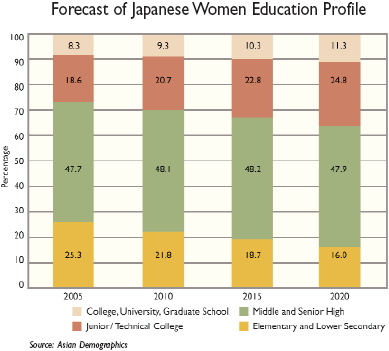
The combination
of a slow growing economy, where new and good jobs are harder and
harder to come by,
along with a less competitive educational background compared with
men, Japanese women’s labor force participation is not expected
to increase in the coming decades. Women’s labor force participation
rate, which has been hovering around 60% of those 15 to 64 years
old, is likely to stay unchanged for the foreseeable future as illustrated
in the next chart.
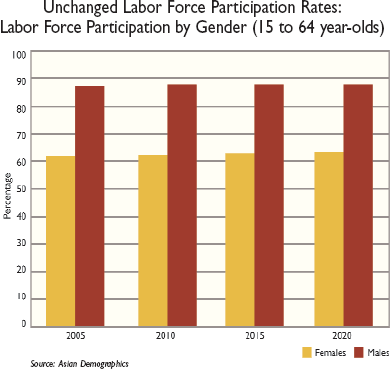
Japanese women’s
consumption power, given the factors discussed above, would appear
to be weak in comparison with men, and likely to remain weak in
the future. This overall picture, however, hides an important segment
that is poised to become more powerful and important in terms of
their wealth, longevity and active lifestyles– Japan’s older women.
The
rising role of older women
The older Japanese
population continues to be economically active, often pushing back
retirement age to 70 and beyond. Most of the so-called “junior”
seniors, those between 60 to 70 years old, are in good health and
want to continue to work. Many are actually supporting their fully-grown
children economically. In a recent survey of those aged 60 to 64,
70% of men and 40% of women expressed their desire to continue working6.
Among the elderly,
women will dominate. In 2004, Japanese women had a life expectancy
of 85 years, while for men it was 78 years. Most Japanese wives
outlive their husbands by some 10 years.
The emerging
picture of Japan’s seniors, however, has become more complex. It
is clear that they live healthier and more active lives than those
a generation or two ago. It has been estimated that only 13% of
those presently over 65 years old require regular care. There are
a wide variety of organizations, many supported by the government,
to serve as caregivers to the elderly. These include social welfare
foundations, private companies, agricultural cooperatives, as well
as consumer cooperatives. The government also launched the comprehensive
Long-Term Care Insurance in 2000.
The older Japanese
are not only relatively healthy, but they are also relatively prosperous.
The average household income for an elderly person in Japan, irrespective
of the type of household (empty nesters or old singles), is only
10% less than the overall household average.
In addition
to their relatively high income, the elderly also hold the largest
share of accumulated privately-held assets in Japan7.
As much as 70% of all privately-owned assets in the country, including
all real estate assets, belong to those over 50 years old. Another
indicator of the financial strength of the older people is the amount
of inheritance they leave behind. In the past 10 years, the average
size of inheritance left by the elderly of Japan was US$330,000,
not an insignificant sum.
These healthy,
active, and financial well-endowed older Japanese have been characterized
as the “silver aristocrats.”8 Their priorities in life
are to:
- Have time and space to do things by themselves.
- Be free from excessive social demands.
- Be able to lead youthful lifestyles.
- Be able to pursue the finer things in life, such as art and classical music.
- Be able to live for pure leisure.
As the Japanese
are living longer and longer, it is possible to identify “sub-segments”
within the older segment. First, there is a population of older
workers between the ages of 50 to 75. After 75, the period of “old”
old age begins. Indeed, there is a movement for seniors over 75
years old called “New Old People’s Movement,” founded by Dr. Hinohara
Shigeaki, 92, a practicing medical doctor. He counsels the elderly
that “…the most important factor is one’s outlook on life. Be optimistic.
Enjoy new experiences. Do what you want to do.”
Thus, these
silver aristocrats are rather self-indulgent people, which resonates
with Japan’s traditional cultural values. Ruth Benedict, in her
seminal study of the pre-WW II Japanese society9 , made
the profound observation that “…the arc of life is plotted in opposite
fashion to the United States. It is a great shallow U-curve, and
maximum freedom and indulgence allowed to babies and the old.”
Japan’s highly
urbanized environment is also very conducive to the lifestyles of
these silver aristocrats where a wide variety of leisure activities,
entertainment, and sophisticated amenities are on tap. Indeed, the
largest urban centers of Tokyo, Osaka, and Nagoya have seen the
fastest growth in recent years within the older segment of their
populations. Again, this is a trend opposite to that of western
societies where the elderly tend to retire to the countryside. This
makes the consumer market of the elderly very easy for businesses
to access.
These silver
aristocrats will certainly continue to indulge themselves. They
have increased their spending on education (a strong indicator of
their lifestyle in seeking new challenges and pursuing new interests),
recreation (including overseas travel), as well as on transportation
and communications. The elderly between 60 and 75 spend most on
socializing– spending time with friends and pursuing new hobbies
together. A whole new service industry has come into existence catering
to the special needs of these silver aristocrats: 24-hour convenience
stores, department stores that feature more refined products, take
away restaurants, health spas, continuing
education centers, and amateur associations dedicated to the pursuit
of a wide variety of hobbies and interests.
As mentioned
earlier, when the empty nester households become the old singles
households, it is the elderly women who are left in charge.
Given that the
average Japanese wife outlives her husband by over 10 years, to
a large extent the silver aristocrat phenomenon is all really about
the elderly women– in their 70s and above, living in urban areas,
financial well-endowed, healthy and active, well networked and plugged
into a sophisticated support system that caters to their needs and
lifestyle pursuits.
The
emerging women consumers of Japan
The emerging
women consumer market in Japan features two dominant segments– the
young singles and the old singles. The rise of the young singles
is a consequence of the trend of not marrying or marrying late.
The rise of the old singles is a consequence of women’s longevity
and increasingly active lifestyles. This situation is graphically
summarized in the following chart, highlighting the changes anticipated
from 2003 to 2013.
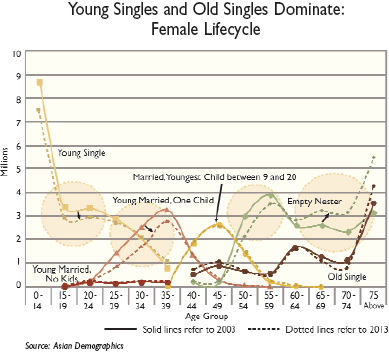
Consumption
by women consumers, segmented by lifecycle stages, is expected to
grow from US$487 billion in 2003 to US$568 billion in 201310
. This represents an average of 1.5% growth per year as shown in
the following chart.
However, this
average hides significant differences that exist in the different
lifecycle stage segments. The empty nesters segment is expected
to be the fastest growing, at 3.2% per year in the coming decade.
This is followed by the old singles segment at 1.8% per year. The
young singles segment, on the other hand, is expected to grow quite
slowly at 0.7% per year. Elderly women, as represented by both the
empty nesters and old singles segments, will command some US$313
billion of spending power in 2013.
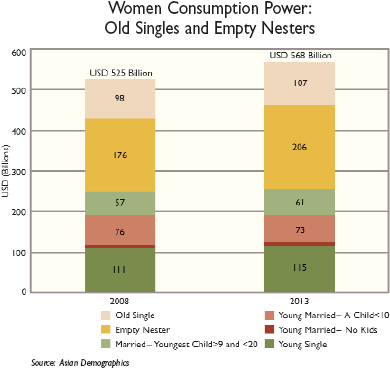
For the older
women segment, the demand for services is expected to be greater
than demand for consumer goods and products. This is good news for
businesses that are targeting this segment. Demand for consumer
goods and products tend to have a low saturation threshold, whereas
demand for services could expand virtually indefinitely as long
as consumers are provided with new and satisfying experiences. The
growth of demand for services will be limited only by businesses’
ability to innovate.
1. Unless otherwise
specified, all demographic data and forecasts are provided by Asian
Demographics, a specialist in the analysis and forecasting of demographic
trends and patterns in Asia/Pacific. For more information on Asian
Demographics, please visit <www.asiandemographics.com>.
2.
Fertility rate (or more accurately “total fertility rate”) refers
to the number of children a woman has in her lifetime.
3.
Howls of the Loser Dogs, by Junko Sakai.
4.
AERA, March 2005.
5.
Philip Brazer, The Japan Times.
6.
Hakuhodo Institute of Life and Living Study.
7.
Hakuhodo Institute of Life and Living Study.
8.
John McCreery, Japanese Consumer Behavior: From Worker Bees to Wary
Shoppers.
9.
The Chrysanthemum and the Sword, 1946.
10.
In constant 2003 US$ based on the average 2003 exchange rate.
;
SOURCE
: http://www.mastercard-masterindex.com
;
;
;

